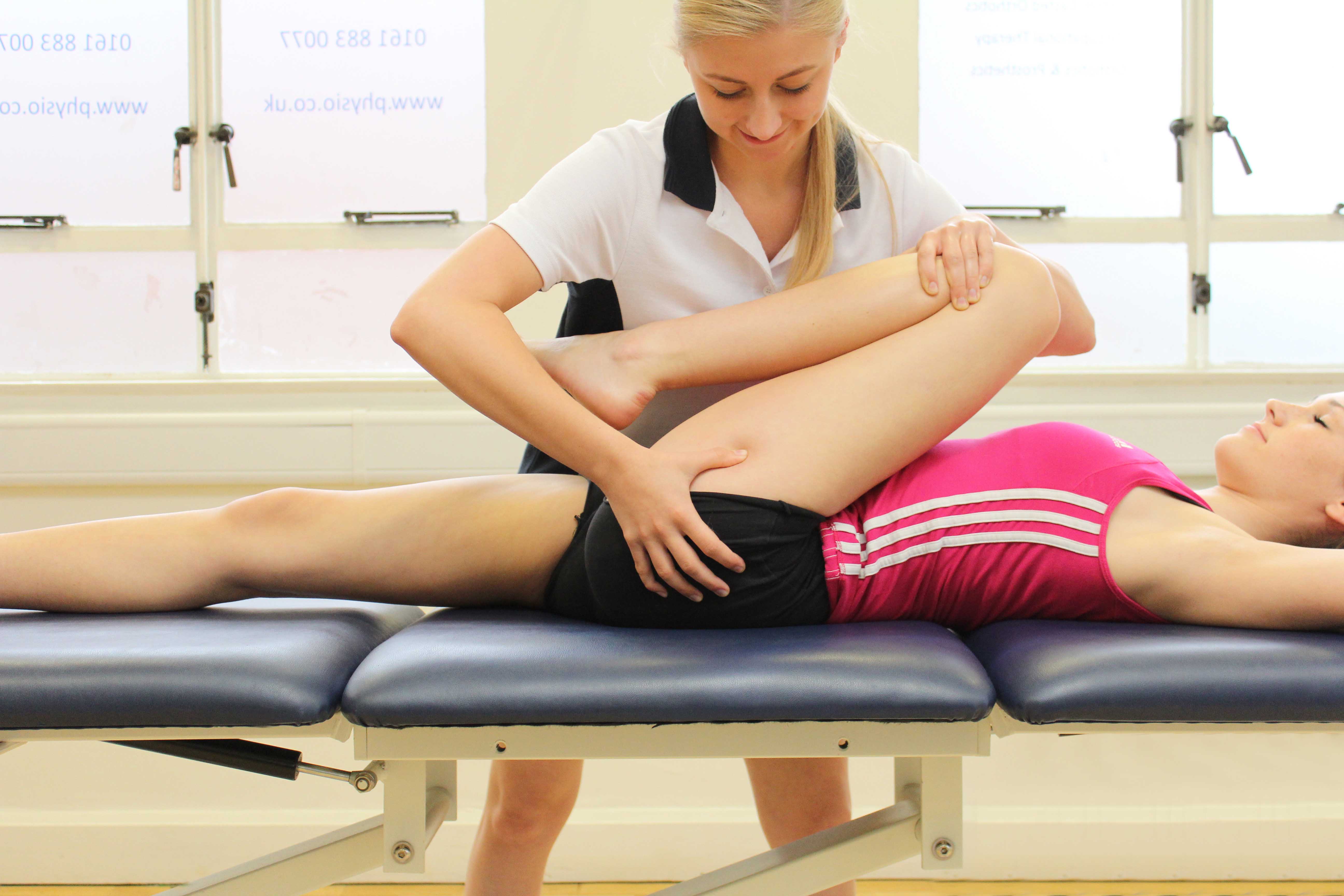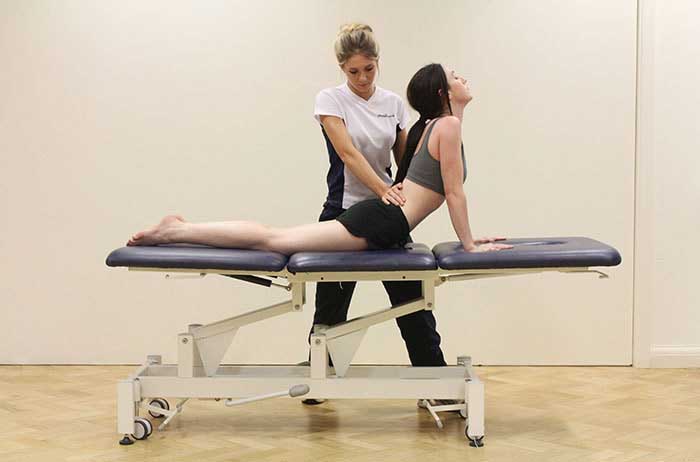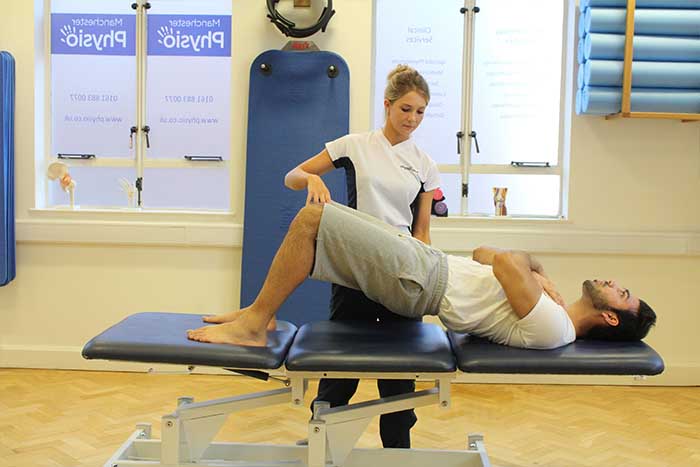Increased flexibility is a common benefit gained through massage. Flexibility of muscles can be reduced for a variety of reasons. The most common causes of reduced flexibility include muscle over use, muscle tightness and inflammation. When flexibility of a muscle is reduced, this can result in a restriction of movement and an increase in pain. Our massage therapists at Physio.co.uk increase flexibility through massage to help increase range of movement and improve performance.
What are the most appropriate types of massage to increase flexibility?
A range of massage types are appropriate for the increase of flexibility. The most common types of massage used include:
 Above: Soft tissue massage of bicep femoris
Above: Soft tissue massage of bicep femorisThe most common types of massage used to increase flexibility include deep tissue massage, sports massage and therapeutic massage.
A deep tissue massage is often used to increase flexibility. A deep tissue massage varies in pressure throughout depending on personal preference. A deep tissue massage focuses on soft tissues around the body. Flexibility is increased through deep tissue massage by the relief of muscle tightness and tension. By getting deeper into muscles through deep tissue massage, inelasticity of muscular tissues decreases and range of movement increases. Increasing elasticity and range of movement help to increase flexibility.

Flexibility is increased through sports massage. A sports massage is focused on areas containing soft tissues and can often be an intense style of massage. A sports massage increases muscle temperature by using various techniques throughout. Reducing restriction and increasing elasticity is a main aim of a sports massage targeting to relieve pain. Reducing restriction through sports massage helps to increase flexibility of both muscles and joints.
A therapeutic massage can be used to increase flexibility. A therapeutic massage aims to manipulate muscles using a variety of techniques. The manipulation of muscles produces a therapeutic effect, increasing relaxation both physically and mentally. A therapeutic massage focuses on superficial layers of muscles and tissues encouraging them to relax and loosen. Loosened and relaxed muscles causes an increase in flexibility and a decrease in pain. The relaxation effect a therapeutic massage has also helps to improve a person's mood reducing stress and anxiety.
 Above: Soft tissue massage of vastus lateralis and illio-tibial band
Above: Soft tissue massage of vastus lateralis and illio-tibial bandWhat techniques are used to increase flexibility?
Flexibility is increased using a variety of techniques. The most common techniques used to increase flexibility include:
The most common techniques used to increase flexibility include deep strokes, kneading and myofascial release.
Deep strokes can help to increase flexibility. Deep strokes involve applying a firm pressure to the treatment area. Flattened hands and fingers are used during deep strokes with the aim to get deep within muscle fibres. Deep strokes create friction between the skin and fingers, increasing blood flow. An increase in blood flow increases muscle temperature. Tissue inelasticity is reduced when temperature increases allowing muscle to relax and stretch. Relaxing and stretching muscles results in increased flexibility.
Kneading increases flexibility. Kneading involves the pulling and squeezing of soft tissues. The pulling and squeezing actions used within kneading encourage increased blood flow to the treatment area. An increase in blood flow results in a rise in muscle temperature. Rising the temperature allows the pulling and squeezing actions to stretch and loosen tight and tense muscles. Stretching and loosening tight and tense muscles increases flexibility. Increasing the flexibility of muscle that were originally tight and tense helps to decrease pain and increase relaxation.
Flexibility can be increased through myofascial release. Myofascial release is used on areas containing soft tissues and fascia. Fascia provides structure and support within structures of the body but can also be restrictive increasing pain. After an injury, fascia hardens and scars. Hardened fascia decreases flexibility. Myofascial release aims to loosen hardened fascia in order to increase flexibility. Temperature of fascia increases during a massage allowing a therapist to apply more pressure to the treatment area. The more pressure applied to the treatment area, the deeper into the layers of tissue a therapist is able to get to help stretch and loosen the fascia. As fascia is stretched and loosened, restriction is reduced and flexibility is increased.

When can a massage help to increase flexibility?
A massage can help to increase flexibility in a variety of situations. Situations that are most commonly helped by increasing flexibility include:
The most common situations increased flexibility through massage can help include pre event, relaxation and tight muscles.
Increased flexibility can help a person pre event. Before an event, a person's muscles tend to be tight and tense due to the intensity of training. Muscles that are tight and tense are more likely to be injured during the event due to over stretching the muscle. During a massage muscles are stretched and loosened. Flexibility of the muscle and joint is increased due to the stretching and loosening of muscles. Increasing flexibility allows full range of movement of the muscle and the joint. Allowing full range of movement reduces the chance of injury during the event and can also improve the persons overall performance.
Relaxation is improved when flexibility increases. When flexibility of a muscle is poor, muscle tightness and tension can occur reducing relaxation. Relaxation is reduced as tight, tense muscle increase pain and restrict movement. During a massage, flexibility is increased due to an improvement in tissue elasticity. Improving flexibility of a muscle helps to relieve muscle tightness and tension, relaxing the muscle and reducing restriction. The relief of tight, tense muscles reduces pain and improves physical relaxation.
Increasing flexibility through massage can help relieve tight muscles. Inflexible muscles results in muscle tightness. Muscle tightness can increase pain and decrease range of movement. Restricting range of movement can increase levels of stress which can further increase muscle tightness. Tissue elasticity is increase during a massage due to an increase in temperature. An increase in tissue elasticity, increases flexibility and range of movement. An increase in range of movement relieves muscle tightness. Relieving muscle tightness reduces pain and stress.
What are the physiological effects of massage to increase flexibility?
Various physiological effects occur during a massage to help increase flexibility. The most common physiological effects that occur include:
The most common physiological effects that occur during a massage to increase flexibility include increase temperature, the breakdown/realignment of collagen fibres and increase tissue elasticity.
Increased temperature often occurs during a massage to help increase flexibility. An increase in temperature occurs in both superficial and deep layers of tissue. An increase in temperature can help to relax and loosen a muscle or a joint. Temperature increases due to friction created between the sin and finger which increases blood circulation. An increase in temperature allows muscle tissues to increase in elasticity, relaxing a muscle and reducing muscle tightness. A reduction in muscle tightness helps to increase flexibility of both the muscle and the joint the muscle surrounds.
The breakdown/realignment of collagen fibres can occur throughout a massage to increase flexibility. Breaking down and realigning collagen fibres is the process of breaking down cross links made up of collagen fibres that are formed to heal an injury. Collagen fibres can be fibrous and are very tough making them useful for the repair of damaged tissues. Collagen fibres lie in a haphazard position over muscle fibres, making movement harder and flexibility to reduce. When temperature increases during a massage, the rise in temperature of collagen fibres causes them to soften enabling the therapists to then break down the cross links. Once the cross links are broken down, a range of techniques are used to realign the collagen fibres with the body's natural muscle fibres. Aligning the collagen fibres with the body's natural muscle fibres helps to increase movement and therefore flexibility.
Flexibility is increased when tissue elasticity increases. Tissue elasticity is the ability of a muscle to stretch to its full length with no restriction or pain. When tissue elasticity is restricted, muscle flexibility reduces. Inflexible muscles can cause muscle tightness and can increase pain. As temperature of tissues increase during a massage, the elasticity of tissues increases. Increasing tissue elasticity allows a muscle to relax and stretch, increasing range of movement. An increase in range of movement increases flexibility.
Summary
Increased flexibility involves increasing the elasticity and movement within both muscles and joints. A range of different massage types can be used to increase flexibility including deep tissue massage, sports massage and therapeutic massage. Various techniques including deep strokes, kneading and myofascial release are often used to increase flexibility. The most common situations that increasing flexibility through massage can help include pre event, relaxation and the tight muscles. Physiological effects including increase temperature, increased elasticity and the breakdown/realignment of collagen fibres all occur during a massage to help increase flexibility. Our massage therapists at Physio.co.uk increase flexibility through massage to help decrease pain and reduce restriction.
How can I arrange a massage to increase flexibility?
The easiest way to arrange a massage to increase flexibility at Physio.co.uk, email us at office@manchesterphysio.co.uk or call us on 0161 883 0077.
You can also book an appointment online and save £10

 0330 088 7800
0330 088 7800


































